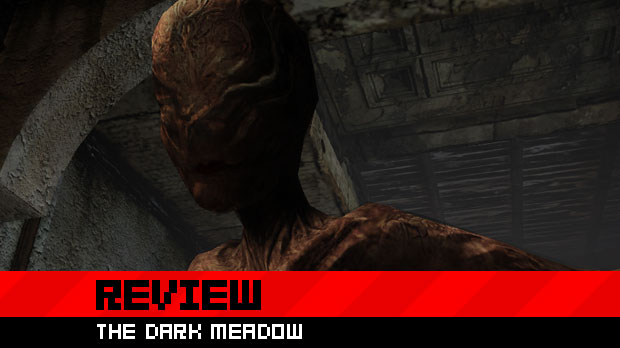Phosphor Games is a studio pulled together from the ashes of Midway. When the company went under, it left behind an open-world superhero game, one that the developers didn’t want to see die. They reformed as Phosphor, and rebuilt the game as Awakened.
We’ve only seen conceptual footage of Awakened, but Phosphor has something a little more substantial for us until the game’s ready to be shown in detail. The studio has taken to the iOS platform, armed with Unreal technology and looking to tell a story.
It’s a story that’s well worth being told.

The Dark Meadow (iOS)
Developer: Phosphor Games
Publisher: Phosphor Games
Released: October 6, 2011
MSRP: $5.99 (standard) / $8.29 (HD)
The Dark Meadow‘s similarities to Infinity Blade are numerous and obvious, needing to be mentioned. Like ChAIR’s smash-hit iOS title, The Dark Meadow takes the form of a timed combat game in which players must dodge or block incoming enemy attacks and swipe the screen to hit back once the opponent’s exhausted itself. It’s a tested system, one that still works very well, although Phosphor doesn’t include parry attacks as Infinity Blade does.
As well as melee combat, The Dark Meadow throws in ranged assaults. Each enemy starts at the end of a corridor and staggers toward the player. During this time, players must dodge incoming projectiles while aiming and firing a crossbow using very simple touch controls. Once the enemy gets close enough, the crossbow is automatically replaced with a sword for close quarter dueling to take place.
Obligatory role-playing elements are on offer, with experience earned at the end of each battle and forty levels to gain. With each level increase, stat points can be sunk into various attributes, improving ranged or melee damage, crossbow reload speed, defense or health. A huge variety of swords, crossbows, and health-augmenting amulets can also be bought with gold found scattered throughout the environment.

Exploration is a big part of the experience. The Dark Meadow is set in an abandoned hospital consisting of rooms connected by corridors. Rooms contain loot and background story elements, while monsters spawn in the corridors. Pulsing green icons on the floor indicate the next position players will move to once touched. It’s a very simple navigation system, and while some may not appreciate the on-rails nature of movement, I find it perfectly suited to the all-touch control scheme.
As stated, the game owes a lot to Infinity Blade, but where it really stands out is with its exemplary story and atmosphere. The game starts with players waking up in the ruined hospital and meeting a mysterious man in a wheelchair. This man becomes the only guiding voice in the game, constantly communicating with the player via loudspeakers set up in each room. It quickly becomes apparent, however, that he isn’t all that he claims to be, and his increasingly mad commentary — as well as his instructions that you are to kill the beautiful “witch” who barricades important sections of the hospital — paints a picture of an insane and malicious individual.
However, he’s also an incredibly funny character, one very reminiscent of Portal‘s GLaDOS. Each of his broadcasts is a treat, as he regularly struggles to win your trust while pathologically demonstrating just how untrustworthy he is. He’ll thank you for being smart enough to invent the Internet before taunting you by claiming to have just found a huge amount of food. He’ll claim the mysterious woman of the hospital is pure evil while admitting that half of what he’s said about her is a lie. He is, at times, utterly hilarious, and sometimes he’s rather creepy.

This focus on storytelling is the real drive of The Dark Meadow, making it something more than a slightly less polished Infinity Blade and giving it something truly special. As players uncover notes from torn diaries, newspaper clippings, or the insane doodles of madmen who seem to know what’s going on, a very strange and eerie world is created. It’s a funny game, but an altogether foreboding one. A mysterious world that never gets too convoluted or obtuse, and provides just enough information to keep one hungry for more.
There are definitely some issues that hold it back. Loading times can be lengthy and the frame rate sometimes gets spotty. The combat system isn’t quite as refined as the game it’s borrowed from, either. The dark visuals can make incoming attacks a little difficult to see and the dodge button seems incredibly forgiving, with attacks that should hit the player passing through so long as a dodge was activated at some point in the enemy’s animation.
My other big problem with the game is the store. Every single item of equipment is available from the start, provided one has the gold for it, and it seems to defeat the object of collecting any loot. Furthermore, this seems designed to encourage in-app purchases of gold. Players can buy their way to the top with gold purchases starting at $0.99 and climbing to an outrageous $49.99! Of course, these purchases are totally voluntary and gold can be achieved through simple grinding, but it will take a lot of time to save up for the most powerful gear.

The best equipment isn’t needed to experience the full game, and it’s still a very fine game indeed. Designed very well around the limitations of iOS and featuring some of the most disturbing creature designs this side of Silent Hill, Phosphor has created a very atmospheric and engrossing game with a delicious streak of dark humor coursing through its veins. The Dark Meadow is worth picking up for anybody with an interest in iOS gaming.





Published: Oct 10, 2011 05:00 pm